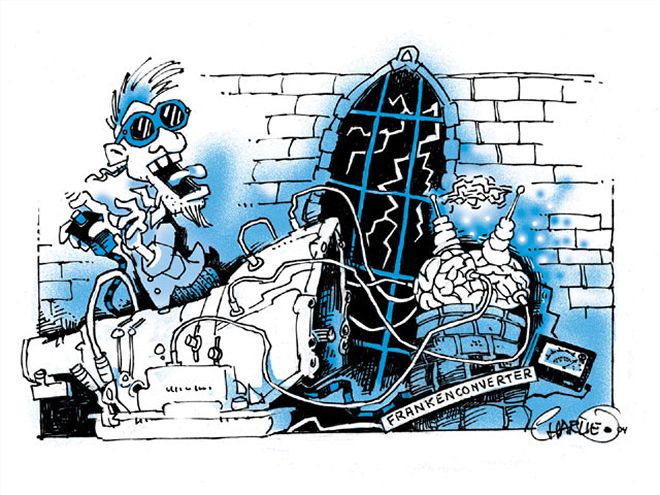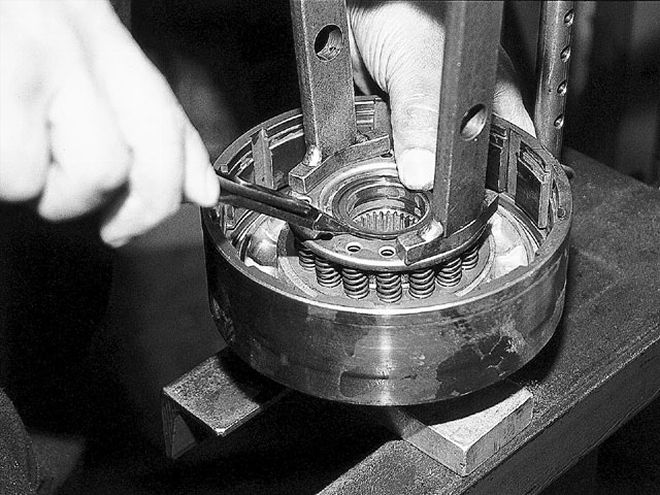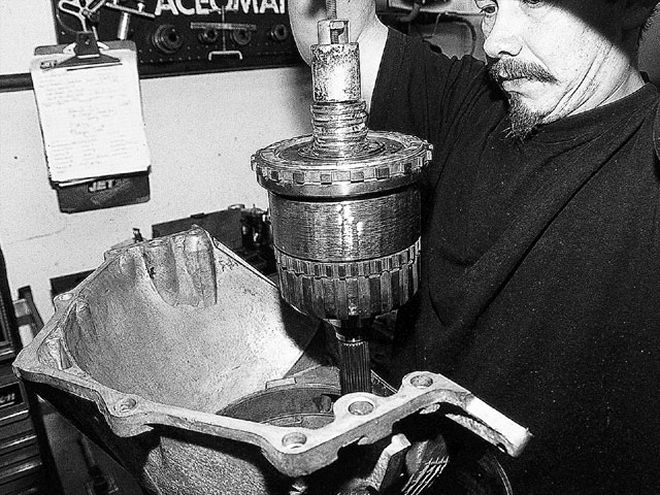
| gm 4l80e Transmission Basics By Jet Performance cartoon
When you speak of the advancements in new-generation trucks, it's typical for the conversation to turn immediately to engines. Words such as sequential port injection, overhead cams, mass airflow sensor, all-aluminum construction, speed-density system, and so on come to the surface, but the greatest advancement is the way we have made our drivetrains smarter.
Sensors feed information to a computer that tunes the fuel and timing for maximum performance in the given situation. This has not only increased power per cubic inch with better fuel economy, but it has also provided the modern engine a much greater life expectancy.
Just look at the trucks for sale in your local paper. New trucks have more miles because of increased commuting, but they still hold a decent value, since they run exceptionally well for the amount of miles they rack up. Years ago, you wouldn't think of getting anything out of a newer vehicle with 100,000 miles - except $40 bucks from your local dismantler. Advancements in machining and materials coupled with electronic management play a part in this increased quality, and the improvements are truly incredible.
OK, so what does this have to do with transmissions? Well, the same technology that has given engines a brain has been incorporated into the newer transmissions. The first true GM electronic tranny didn't come around until 1991. It was a 4L80E and was only equipped with trucks that had big-blocks. After GM got its nose bloody with the 700R4 (the first smaller version of an overdrive tranny), the 4L60E replaced it in 1993. The 4LE-series transmissions have come a long way from the old 350 and 400 Turbo Hydromatics that coupled the earlier engines to their differentials.
We contacted the guys at JET Performance Products in Huntington Beach, California, for a peek inside the differences between the new transmissions. After talking with them, and getting lost a few times, it was quite clear that covering all the functions of a transmission would basically take a year of our entire editorial calendar, and that wouldn't even touch the more complex theory of transmission functions. So we decided to pull out the best parts and bring you what JET does to beef up the tranny and how the basics work.
We used the 4L80E to show the buildup. The 4L60E uses a lot of the same electronics, except it uses the engine rpm for the input speed. Other than that, the upgrade approach is similar.
Basic Transmission OperationStandard and automatic transmissions serve the same purpose. They change the gear ratio between the engine and differential to keep the engine working in its sweet spot without lugging or over-revving the engine for a given range of speed. The difference is that an automatic transmission engages and shifts gears without the need of intervention. It does this through a series of inputs nodes, ranging from the mechanical position of the shift linkage to the engine's vacuum. Newer transmissions incorporate electronics that help a computer determine the optimum slip and gear selection for the load at hand.
Hydraulic FluidThe torque converter attached to the engine spins a hydraulic pump. This pump has the ability to put out about 700 psi. There are several different obstacles in the tranny that reduce the hydraulic pressure to about a 60-psi normal operating pressure. When the shift linkage is moved, it allows hydraulic fluid to flow or pressurize certain passages in the trans. This is what engages, slips, or disengages the gears in the transmission.

| gm 4l80e Transmission Basics By Jet Performance clutch Assembly
Clutches And SpringsThere are five gears in a four-speed overdrive transmission: First, Second, Third, Overdrive, and Reverse. All of these gears have a clutch assembly that uses springs to keep the gear disengaged. When hydraulic fluid pressurizes a passage associated with that gear, it pushes against the springs and mashes the clutches together, which engages that gear.

| gm 4l80e Transmission Basics By Jet Performance gear
GearsEach gear in an automatic tranny is not a single gear alone that is engaged or disengaged by itself. Instead, it is a combination of gears that create a certain gear ratio for the five different output speeds or directions. This is done by way of what is called a planetary gear assembly.
A planetary gear assembly is made up of three different types of gears. By controlling the gears in this assembly, you can change its gear ratio and direction. It takes three planetary gear assemblies to make up the five different gears ratios in the 4L80E.
S = Sun GearThe sun gear is the center gear in the planetary assembly.
P = Planetary GearsThe planetary gears are the four gears that surround the sun gear.
C = Carrier GearThe carrier gear houses the sun and planetary gears.
Each planetary gear assembly puts out a different gear ratio by simply locking or unlocking the carrier gear, sun gear, or planetary rotation with the clutch plates. By locking the carrier only, the sun gear spins with the planetary gears inside the carrier, which renders a certain gear ratio. Locking the sun gear makes the carrier gear spin the planetary gears, which changes the gear ratio as well as changes the rotation. Leaving both gears unlocked prevents planetary rotation, and again changes the gear ratio from either of the other ratios. With three of these planetary gear assemblies in a transmission, you can see how this can quickly get confusing.
The ideas we've conveyed are not the exact science; there are about a million other things going on that make up the automatic transmission. But these basic tidbits will make it easier to understand how all the performance upgrades affect an automatic tranny.
Computer-controlled transmissions have really changed automatics forever. Just as fuel injection has made the engine more powerful, functional, and reliable, the electronic transmission outperforms and outlasts any of its predecessors with a stock engine. With JET Performance upgrades, the 4L60E is good for about as much as 500 hp, and the 4L80E is good for about as much as 800 hp. JET also carries a stand-alone computer to control the tranny, in case you want to adapt it to a computer-free engine.
 | gm 4l80e Transmission Basics By Jet Performance cartoon
When you speak of the advancements in new-generation trucks, it's typical for the conversation to turn immediately to engines. Words such as sequential port injection, overhead cams, mass airflow sensor, all-aluminum construction, speed-density system, and so on come to the surface, but the greatest advancement is the way we have made our drivetrains smarter.
Sensors feed information to a computer that tunes the fuel and timing for maximum performance in the given situation. This has not only increased power per cubic inch with better fuel economy, but it has also provided the modern engine a much greater life expectancy.
Just look at the trucks for sale in your local paper. New trucks have more miles because of increased commuting, but they still hold a decent value, since they run exceptionally well for the amount of miles they rack up. Years ago, you wouldn't think of getting anything out of a newer vehicle with 100,000 miles - except $40 bucks from your local dismantler. Advancements in machining and materials coupled with electronic management play a part in this increased quality, and the improvements are truly incredible.
OK, so what does this have to do with transmissions? Well, the same technology that has given engines a brain has been incorporated into the newer transmissions. The first true GM electronic tranny didn't come around until 1991. It was a 4L80E and was only equipped with trucks that had big-blocks. After GM got its nose bloody with the 700R4 (the first smaller version of an overdrive tranny), the 4L60E replaced it in 1993. The 4LE-series transmissions have come a long way from the old 350 and 400 Turbo Hydromatics that coupled the earlier engines to their differentials.
We contacted the guys at JET Performance Products in Huntington Beach, California, for a peek inside the differences between the new transmissions. After talking with them, and getting lost a few times, it was quite clear that covering all the functions of a transmission would basically take a year of our entire editorial calendar, and that wouldn't even touch the more complex theory of transmission functions. So we decided to pull out the best parts and bring you what JET does to beef up the tranny and how the basics work.
We used the 4L80E to show the buildup. The 4L60E uses a lot of the same electronics, except it uses the engine rpm for the input speed. Other than that, the upgrade approach is similar.
Basic Transmission Operation
| gm 4l80e Transmission Basics By Jet Performance cartoon
When you speak of the advancements in new-generation trucks, it's typical for the conversation to turn immediately to engines. Words such as sequential port injection, overhead cams, mass airflow sensor, all-aluminum construction, speed-density system, and so on come to the surface, but the greatest advancement is the way we have made our drivetrains smarter.
Sensors feed information to a computer that tunes the fuel and timing for maximum performance in the given situation. This has not only increased power per cubic inch with better fuel economy, but it has also provided the modern engine a much greater life expectancy.
Just look at the trucks for sale in your local paper. New trucks have more miles because of increased commuting, but they still hold a decent value, since they run exceptionally well for the amount of miles they rack up. Years ago, you wouldn't think of getting anything out of a newer vehicle with 100,000 miles - except $40 bucks from your local dismantler. Advancements in machining and materials coupled with electronic management play a part in this increased quality, and the improvements are truly incredible.
OK, so what does this have to do with transmissions? Well, the same technology that has given engines a brain has been incorporated into the newer transmissions. The first true GM electronic tranny didn't come around until 1991. It was a 4L80E and was only equipped with trucks that had big-blocks. After GM got its nose bloody with the 700R4 (the first smaller version of an overdrive tranny), the 4L60E replaced it in 1993. The 4LE-series transmissions have come a long way from the old 350 and 400 Turbo Hydromatics that coupled the earlier engines to their differentials.
We contacted the guys at JET Performance Products in Huntington Beach, California, for a peek inside the differences between the new transmissions. After talking with them, and getting lost a few times, it was quite clear that covering all the functions of a transmission would basically take a year of our entire editorial calendar, and that wouldn't even touch the more complex theory of transmission functions. So we decided to pull out the best parts and bring you what JET does to beef up the tranny and how the basics work.
We used the 4L80E to show the buildup. The 4L60E uses a lot of the same electronics, except it uses the engine rpm for the input speed. Other than that, the upgrade approach is similar.
Basic Transmission Operation | gm 4l80e Transmission Basics By Jet Performance clutch Assembly
Clutches And Springs
| gm 4l80e Transmission Basics By Jet Performance clutch Assembly
Clutches And Springs | gm 4l80e Transmission Basics By Jet Performance gear
Gears
| gm 4l80e Transmission Basics By Jet Performance gear
Gears